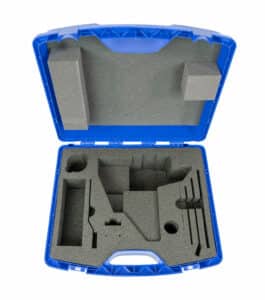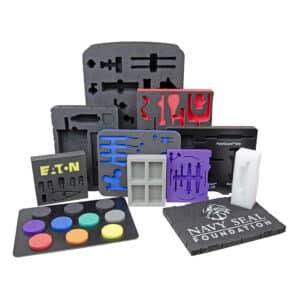How CNC Foam Cutting Gives You Perfect Custom Foam Inserts

CNC (Computer Numerical Control) foam cutting, sometimes known as laser cutting, precision cutting, or computer-aided cutting, is an advanced manufacturing process that uses multiple cutting technologies to create custom foam inserts for industrial packaging solutions. As specialists in foam conversion, we leverage state-of-the-art CNC machinery, including routers and single or dual cutting head waterjets to deliver precision-engineered packaging foam solutions to meet a broad variety of industrial and commercial needs.
What Type Of Foam Is Used?
Many custom-cut foam inserts are typically manufactured from polyethylene foam (PE foam or PEF).
Polyethylene Foam (PE)
A vast majority of custom-cut foam inserts are manufactured from polyethylene foam (PE foam). Plastazote and PE block foams, are both premium grades of PE foam commonly selected over other foam material options for several key reasons:
- Exceptional waterjet cutting and routing compatibility
- Minimum material distortion
- Closed-cell structure preventing moisture absorption
- Optimal cutting and engraving properties
- Produces bulk volumes of consistently precision cut foam inserts
- Suitable for scalable production
Polyethylene foam’s outstanding durability and flexibility make it ideal for keeping equipment safe during transit. Its shock-absorbing properties and resistance to repeated compression make it perfect for precision engineered foam packaging solutions for transit damage prevention whilst maximising efficiency and organisation for industrial and commercial clients.
Alternative Foam Options
As a leading supplier of high-volume, custom cut packaging and presentation foams designed to meet the needs of businesses requiring scalable, precision foam engineered solutions. Beyond polyethylene foam, we offer a diverse range of high-performance foams, expertly cut and customised using a variety of cutting and fabricating methods to meet your exact specifications. Whether you need foam pads, end caps, foam trays, protective or presentation foam inserts for cases, boxes, custom bags or tool control drawer liners, we provide cost-effective, bulk-order solutions tailored for efficiency, protection and brand presentation.
As experienced foam conversion specialists we understand the importance of considering a product’s size, weight, fragility, cost and expected handling conditions as some of the key factors when selecting a foam material. For some alternative types of packaging foam, we will use different foam-cutting machinery, including a band knife, profiler and die-cutting press. To learn more about all of the foam cutting processes, you can read our Foam Cutting: The Step by Step Process guide.
What Machinery Is Used To Cut The Foam?
To cut the foam, we use a range of CNC cutting techniques, these include routing and waterjet cutting which is also referred to as laser cutting but differs from laser cutting as it uses pressurised water to produce the cuts as opposed to a light beam. These high-tech CNC machines enable us to take foam materials and convert them into usable packaging and presentation foam products. We work closely with businesses to understand requirements and guarantee the highest quality foam product solutions every time.
Why Use a Custom Cut Foam Insert?

Custom designs and CNC-cut foam inserts provide ideal organisation and storage solutions for specialised tools, delicate instruments, and promotional product samples.
These inserts not only protect your equipment but also create a professional, organised presentation that enhances product displays.
They are not only great for the presentation of sample products, allowing you to present and demonstrate items, but they are also the perfect solution for keeping equipment safe during transit.
The precision design allows the foam to fit precisely around the item, meaning no movement will cause breakages or transit damage and prevent costly losses or downtime.
Applications and Benefits
Custom CNC-cut foam inserts excel in numerous applications:
- Industrial tool organisation and protection
- Medical instrument storage
- High-value product presentation
- Test and measurement equipment transportation
- Calibration equipment protection
- Sales and marketing sample presentation or demo kit cases
- Trade exhibition or product launch cases
The Design and Manufacturing Process
Step 1. Product design & specification
Case selection based on specific protection requirements:
Before we can begin the design of the foam insert for a case, the starting point is to confirm if it is just a foam insert we are supplying or a case, bag or box with a foam insert. If we are to supply the outer carrying solution also then the first decision is to decide on the hard or soft case that is most suitable to your needs. No matter what kind of item you’re looking to keep safe, whether it’s promotional products or high-value equipment, it’s imperative that you have a protective packaging or transit solution that you can rely on.
Product layout optimisation:
 Thanks to the wide array of sizes and product types available today, there is now a hard or soft case for almost every application and if there is not we can design and manufacture one for you. When making suggestions for a case solution, the process is very similar to the foam inserts process, and we will begin by discussing and asking for details such as product sizes, weights, fragility, cost and expected handling conditions so we suggest a solution fit for the purpose it is intended to be used for.
Thanks to the wide array of sizes and product types available today, there is now a hard or soft case for almost every application and if there is not we can design and manufacture one for you. When making suggestions for a case solution, the process is very similar to the foam inserts process, and we will begin by discussing and asking for details such as product sizes, weights, fragility, cost and expected handling conditions so we suggest a solution fit for the purpose it is intended to be used for.
If the solution is a standard hard or soft case solution, the foam insert will be housed within. We begin by arranging the sample products, instruments or equipment that will be housed within the case, bag or box to allow us to gauge an overall size and select a suitable case model. Alternatively, if custom-made case solutions are to be manufactured we will work from the overall foam insert size needed and then create the case around this.
Next, the designer will lay out all of the items either physically if samples have been supplied or digitally if we are supplied with CAD drawings, allowing the designer to understand the positioning of the items and how they fit together within the foam layout.
Their experience and expertise will enable them to allow for any depth variations, intricate details or heavy items that may need additional support or protection whilst maintaining a design layout that can be translated into an effective protective engineered foam solution whilst working within minimum tolerances and machining capabilities.
Design verification and customer approval process:
If physical product samples have been supplied the design team will take a picture of the arranged items in the proposed layout (sometimes inside the empty case) and share the proposed layout for customer approval. Once approved this layout is used as a guide for the programmer to create the relevant programme to custom-cut the foam.
Step 2. Programming, cutting or routing the foam
CNC machine setup and calibration:
Once the layout is approved and a program is created within the relevant software, the file is sent to the machine. A test cut will be produced and once this has been thoroughly checked for quality and fit the machine will then be loaded with the chosen foam sheet for the manufacturing to begin.
Precision-cutting & quality control:
Once the cutting process is complete with CNC routing, there is a small amount of cleaning up of any loose foam particles and heat sealing the surface of the custom-routed foam inserts to further improve the final finished appearance.
For waterjet cut foam, we will either completely remove or leave the shaped cutouts within the foam insert depending on the agreed design requirement.
A foam pad of the same can be added as backer and can either just sit on top of the foam pad with cut outs, or be attached by either heat welding the two foam pads together or joining with hot melt glue or double sided adhesive tape. The purpose of this foam pad backer is to prevent items sitting against the internal walls of the outer packaging, this method creates cutouts of the same depth throughout the foam layout.
If the foam layout requires the cutouts to have recesses with various depths then cut outs will be removed reduced in depth and then placed back in the foam pad to produce recessed outlines of each item with various depths meaning all items will sit level with the top of the foam insert or easy access and to enhance the presentation of the contents.
Step 3. Assembly
Assembling the finished product:
Once the foam insert is complete, if we are supplying an outer case, bag or box also the insert will be either placed loosely within the outer case, bag or box or if requested permanently fixed in place using either spray adhesive, hot melt glue or double-sided tape.
Further Customisation
We offer complete customisation of the foam. Some additional features and design integrations we are commonly asked for are:
Functional features:
- Elasticated, webbing or velcro retaining straps
- Foam fitting on removable trays with carrying handles
- Finger or handle holes for ease of access
Presentation features:
- Corporate logo or branding cut into the foam insert
- Overlay marketing graphic panels
- Product code labelling or technical information
These customisation options can further promote a consistent, stylish, lasting impression to promote your corporate image.
Precise and Professional CNC Foam Cutting
Our state-of-the-art machinery, combined with over 100 years of expertise in manufacturing protective, presentation and transportation solutions for limitless companies, enables us to produce the highest quality products time and time again. The speed, precision and efficiency of CNC machines mean we never have to compromise on quality. With these fully computerised processes, we can repeatedly produce intricate details in large-scale production.
We pride ourselves on being expert designers, manufacturers and suppliers of protective presentation cases, padded soft bags, custom flight cases and various other heavy-duty equipment transit, presentation or storage solutions for a wide range of industries. If you have any questions or want to enquire about a custom product solution, please get in touch today.
